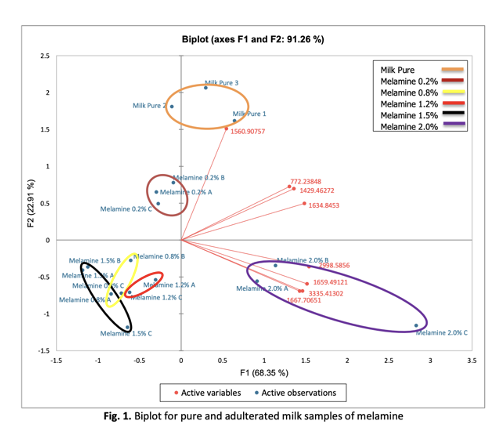Quantification of Adulterant Residues in UHT Milk Products using ATR-FTIR Spectroscopy Coupled with Multivariate Analysis
DOI:
https://doi.org/10.37934/ard.115.1.113Keywords:
Milk adulterant, multivariate analysis, spectroscopyAbstract
Milk adulteration is a dishonest act of some milk manufacturer, where they purposely combine or substitute the ingredient of milk with low quality substances which decrease the quality of the milk. The objectives of this study were to investigate the ATR-FTIR spectroscopy technique in detection of adulterant residues in milk products, and to classify and quantify the adulterant detected in milk sample using multivariate analysis. Ultra High-Temperature (UHT) milk sample was used with three common adulterants (melamine, formalin, anionic detergent) in five different concentrations (0.2 %, 0.8 %, 1.2 %, 1.5 % and 2.0 %). The ATR-FTIR spectroscopic analysis was used for the qualification of adulterants in the wavenumber range of 4000 to 500. Then, principal component analysis (PCA), discriminant analysis (DA) and multiple linear regression (MLR) was applied for multivariate analysis. PCA was used to reduce the dimensionality of the data and to explore the similarities and differences among the unadulterated and adulterated milk samples. DA was used to confirm the significant variable obtain from PCA, and MLR was used to quantify the adulterants detected in the samples. The root mean squared error (RMSE), the coefficient of determination () value obtained for melamine data was 0.158% and 0.975 respectively with the mean square error (MSE) was obtained to be 0.025. Then, the RMSE, and MSE value obtained for formalin were 0.308%, 0.904 and 0.095 respectively while the RMSE, and MSE value obtained for detergent were 0.639%, 0.632 and 0.408. These results show the potential of FTIR spectroscopy coupled with multivariate analysis as a rapid and sensitive technique for the qualification and quantification of adulterant residues in UHT milk products.
Downloads























